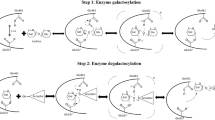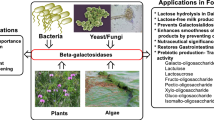Abstract
The gene, AbfAC26Sari, encoding an α-l-arabinofuranosidase from Anoxybacillus kestanbolensis AC26Sari, was isolated, cloned, sequenced, and characterizated. On the basis of amino acid sequence similarities, this 57-kDa enzyme could be assigned to family 51 of the glycosyl hydrolase classification system. Characterization of the purified recombinant α-l-arabinofuranosidase produced in Escherichia coli BL21 revealed that it is active at a broad pH range (pH 4.5 to 9.0) and at a broad temperature range (45–85°C) and it has an optimum pH of 5.5 and an optimum temperature of 65°C. Kinetic experiment at 65°C with p-nitrophenyl α-l-arabinofuranoside as a substrate gave a V max and K m values of 1,019 U/mg and 0.139 mM, respectively. The enzyme had no apparent requirement of metal ions for activity, and its activity was strongly inhibited by 1 mM Cu2+ and Hg2+. The recombinant arabinofuranosidase released l-arabinose from arabinan, arabinoxylan, oat spelt xylan, arabinobiose, arabinotriose, arabinotetraose, and arabinopentaose. Endoarabinanase activity was not detected. These findings suggest that AbfAC26Sari is an exo-acting enzyme.





Similar content being viewed by others
References
Aristidou A, Penttila M (2000) Metabolic engineering applications to renewable resource utilization. Curr Opin Biotechnol 11:187–198
Belduz AO, Lee EJ, Harman JG (1993) Mutagenesis of the cyclic AMP receptor protein of Escherichia coli: targeting positions 72 and 82 of the cyclic nucleotide binding pocket. Nuc Acids Res 21:1827–1835
Bezalel L, Shoham Y, Rosenberg E (1993) Characterization and delignification activity of a thermostable α-l-arabinofuranosidase from Bacillus stearothermophilus. Appl Microbiol Biotechnol 40:57–62
Brice RE, Morrison JM (1982) The degradation of isolated hemicelluloses and lignin-hemicellulose complexes by cell-free rumen hemicellulases. Carbohydr Res 101:93–100
Canakci S, Belduz AO, Saha BC, Yasar A, Ayaz FA, Yayli N (2007) Purification and characterization of a highly thermostable α-l-arabinofuranosidase from Geobacillus caldoxylolyticus TK4. Appl Microbiol Biotechnol 75:813–820
Degrassi G, Vindigni A, Venturi VA (2003) Thermostable α-l-arabinofuranosidase from xylonolytic Bacillus pumilus: purification and characterization. J Biotechnol 101:69–79
Emanuelsson O, Brunak S, Heijne G, Nielsen H (2007) Locating proteins in the cell using TargetP, SignalP and related tools. Nature Protocols 2:953–971
Gilead S, Shoham Y (1995) Purification and characterization of α-l-arabinofuranosidase from Bacillus stearothermophilus T-6. Appl Environ Microbiol 61:170–174
Gunata ZY, Brillouet JM, Voirin S, Baume R, Cordonnier R (1990) Purification and some properties of an α-l-arabinofuranosidase from Aspergillus niger. Action on grape monoterpenyl arabinofuranosylglucosides. J Agric Food Chem 38:772–776
Hata K, Tanaka M, Tsumuraya Y, Hashimoto Y (1992) α-l-Arabinofuranosidase from radish (Raphanus sativus L.) seeds. Plant Physiol 100:388–396
Hespell RB, O’Bryan PJ (1992) Purification and characterization of an α-l-arabinofuranosidase from Butyrivibrio fibrisolvens GS113. Appl Environ Microbiol 58:1082–1088
Hövel K, Shallom D, Niefind K, Belakhov V, Shoham G, Baasov T, Shoham Y, Schomburg D (2003) Crystal structure and snapshots along the reaction pathway of a family 51 α-l-Arabinofuranosidase. The EMBO Journal 22:4922–4932
Kaji A, Tagawa K, Ichimi T (1969) Properties of purified α-l-arabinofuranosidase from Aspergillus niger. Biochim Biophys Acta 171:186–188
Margolles A, de los Reyes-Gavilan CG (2003) Purification of a novel of α-l-arabinofuranosidase from Bifidobacterium longum B667. Appl Environ Microbiol 69:5096–5103
Matuso N, Kaneko S, Kuno A, Kobayashi H, Kusakabes I (2000) Purification, characterization and gene cloning of two α-l-arabinofuranosidases from Streptomyces chartreusis GS901. Biochem J 346:9–15
Miller GL (1959) Use of dinitrosalicyclic acid reagent for determination of reducing sugars. Anal Chem 31:426–428
Pikuta E, Lysenko A, Chuvilskaya N, Mendrock U, Hippe H, Suzina N, Nikitin D, Osipov G, Laurinavichius K (2000) Anoxybacillus pushchinensis gen. nov., sp. nov., a novel anaerobic, alkaliphilic, moderately thermophilic bacterium from manure, and description of Anoxybacillus flavithermus comb. nov. Int J Syst Evol Microbiol 50:2109–2117
Saha BC (2000) α-l-arabinofuranosidase: biochemistry, molecular biology and application in biotechnology. Biotechnol Adv 18:403–423
Saha BC (2003) Hemicellulose bioconversion. J Ind Microbiol Biotechnol 30:279–291
Seri K, Sanai K, Matsuo N, Kawakubo K, Xue C, Inoue S (1996) Arabinose selectively inhibits intestinal sucrase in uncompetitive manner and reduces glycemic response after sucrose ingestion in animals. Metabolism 45:1368–1374
Shallom D, Belakhovb V, Solomonb D, Gilead-Groppera S, Baasovb T, Shoham G, Shoham Y (2002a) The identification of acid-base catalyst of α-l-arabinofuranosidase from Geobacillus stearothermophilus T-6, a family 51 glycoside hydrolase. FEBS Letters 514:163–167
Shallom D, Belakhov V, Solomon D, Shoham G, Baasov T, Shoham Y (2002b) Detailed kinetic analysis and identification of the nucleophile in α-l-arabinofuranosidase from Geobacillus stearothermophilus T-6, a family 51 glycoside hydrolase. J Biol Chem 277:43667–43673
Spagna G, Romagnoli D, Angela M, Bianchi G, Pifferi PG (1998) A simple method for purifying glycosidases: α-l-arabinofuranosidase and β-d-glucopyranosidase from Aspergillus niger to increase the aroma of wine. Enzyme Microb Technol 22:298–304
Van Laere KM, Hartemink R, Bosveld M, Schols HA, Voragen AG (2000) Fermentation of plant cell wall derived polysaccharides and their corresponding oligosaccharides by intestinal bacteria. J Agric Food Chem 48:1644–1652
Ward OP, Moo-Young M (1989) Degradation of cell wall and related plant polysaccharides. CRC Crit Rev Biotechnol 8:237–274
Weinstein L, Albersheim P (1979) Structure of plant cell walls. IX. Purification and partial characterisation of a wall degrading endo-arabanase and an arabinosidase from Bacillus subtilis. Plant Physiol 63:425–432
Acknowledgments
We are grateful to The Scientific and Research Council of Turkey (TUBITAK, Grant no. 104T286) and Karadeniz Technical University Research Foundation (grant no. 2007.111.04.10) for financial support.
Author information
Authors and Affiliations
Corresponding author
Rights and permissions
About this article
Cite this article
Canakci, S., Kacagan, M., Inan, K. et al. Cloning, purification, and characterization of a thermostable α-l-arabinofuranosidase from Anoxybacillus kestanbolensis AC26Sari. Appl Microbiol Biotechnol 81, 61–68 (2008). https://doi.org/10.1007/s00253-008-1584-1
Received:
Revised:
Accepted:
Published:
Issue Date:
DOI: https://doi.org/10.1007/s00253-008-1584-1




